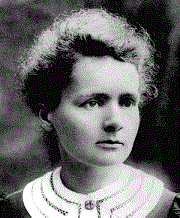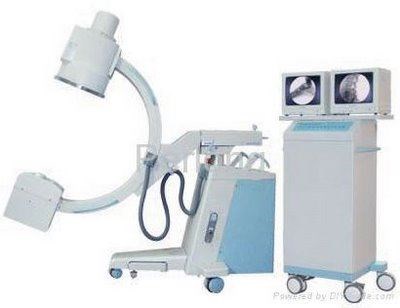 |
| (http://faculty.ssfs.org/~doschel/Images/MarieCurie.gif) |
Science is a sophisticated subject composed of various fields of study. It helps us understand the why and how of everything that takes place. Men have had scientific breakthroughs throughout the history of mankind, but it was only from the late nineteenth century that women were able to participate and contribute to science. Many women were held back because of the stereotypes that stated they were not mentally capable, and could not pursue their goals in scientific research. One woman, named Marie Curie, was passionate about her studies and wanted to contribute her intelligence for the benefit of science and humankind. Although all odds were against her, Marie Curie conquered her adversaries and made scientific discoveries that created new ways of treating patients all around the world. She also inspired other women by expressing a relentless commitment to her work, and by being exemplary of what persistence and hard work could accomplish.
 |
| (http://www.atomicarchive.com/Images/bio/B18.jpg) |
Marie Sklodowska (Curie) was born in Warsaw on November 7, 1867, and was the youngest in a household of 5 children. Her parents were teachers, and they taught her the value of education. She grew up being educated in government schools, and worked as a governess to earn money before moving in with her sister in 1891 to complete her studies in the University of Paris (Marie Sklodowska Curie). While looking for field work, she met Pierre Curie and decided to join his doctoral studies in the field of radiation instigated by Antoine Henri Becquerel. She eventually married him in 1895, and gave birth to Irene in 1897 and Eve in 1904. Marie and Pierre Curie worked in a lab that was, “more like a stable or a potato shed,” (Altena) but still managed to discover two radioactive elements, polonium and radium, that created a whole new field of medicine. She was awarded two Nobel Prizes, the first woman to receive any Nobel Prize in science, once in physics and another time in chemistry. After her husband’s death, she continued to study the properties of radiation and found out that radiation kills cancerous cells. Several of her contributions such as x-rays and chemotherapy are still used to this day. She continued to work without respite until her health began to fail her, and she passed away on July 4, 1934 (Creese, Mary R. S.).
One of Marie Curie’s most noticeable traits of heroism was the overcoming of obstacles. One of the greatest struggles in her life on the way to scientific discovery were gender barriers. “Until the twentieth century, women were generally excluded from scientific and medical careers……most medical schools and graduate science programs remained closed to women” (Women in Science). She had trouble finding a school that would accept her, so she had to move to Paris to study at the University of Paris (Marie Sklodowska Curie). She managed to study and receive her diploma at the top of her class, but still had trouble finding doctoral work until she met Pierre Curie. Although all odds were against her, she still managed to prosper intellectually, and made great contributions to science. “On 20 April 1995, the bodies of Marie and Pierre Curie were ceremoniously transferred to Pantheon I Paris. French President Francois Mitterrand sponsored this honor as a way of acknowledging the equality of women and men,” (MAGNER, LOIS N. Curie, Marie). This shows that Marie Curie’s hard work and sacrifice paid off. She was able to make a President recognize the equality of men and women, and other women from that point on were able to prosper in the field of science.
 |
| (http://1.bp.blogspot.com/_u337ThvlyDw/SWjgObDFtoI/AAAAAAAABq0/IygvztSTDuc/s400/X-Ray+Machine+PLX112.jpg) |
Not only did Marie Curie overcome her obstacles, she also made lasting contributions that are still used in everyday life. After she discovered the two radioactive elements radium and polonium, she discovered several of their properties and helped develop the x-ray, which is used everyday to check up on people’s bones. During the four years of World War I, she helped equip cars with the x-ray, which would significantly help medics figure out what was wrong with soldiers in battle (Marie Sklodowska Curie). Her discovery of radiation and continued research led to a greater understanding of radiation, “Among them was … one which announced that diseased, tumor-forming cells were destroyed faster than healthy cells when exposed to radium” (Marie Sklodowska Curie). Her contributions led to many further investigations and discoveries by other scientists in radiological research, and helped develop chemotherapy and other treatments for diseases. Her discoveries left a lasting mark in the field of science, and are still being used today.
She also serves as an inspiration to other women who were hindered by sexism on their search for work in the field of science. Since she was able to overcome gender barriers, she demonstrated the women were equally capable. She was also able to give influential people the idea that women were as capable as men. “When Dr. Simon Flexner, director of the Rockefeller Institute for Medical Research… called for more women to be scientists… Flexner could cite such examples of women scientists as Marie Curie” (Women in Science). This shows that Marie Curie was a fine example of what potential women had. Although women were still considered inferior, more and more were accepted into universities.
Despite all her suffering, Marie Curie managed to persevere and made contributions to the field of radiology. Her discoveries and observations Radiation today is used to help people medically all over the world. X-rays are used to check people’s bones every day, and chemotherapy helps people get rid of cancerous cells. Her impact on the medical world, domination of her obstacles, and inspiration through her commitment define Marie Curie as a true hero.
Page created on 5/21/2010 12:00:00 AM
Last edited 5/21/2010 12:00:00 AM
